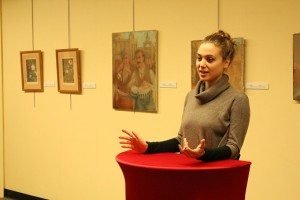WATERTOWN, Mass.—A large crowd gathered at ALMA on the evening of Nov. 15 to learn about a new and exciting variation on an old title, the Houshamadyan Project, presented by project coordinator Nora Lessersohn.

Co-sponsored by ALMA and NAASR, the evening offered an opportunity to hear about the creation of the project and its ongoing evolution. Project director and chief editor Vahe Tachjian works from Berlin with a small team of artists and researchers, joined together by the internet. Gathering and posting information, images, and sounds of a lost world, the Houshamadyan team works to document the daily life, customs, traditions, cuisine and environment of the Ottoman Armenian communities before the genocide.
As Lessersohn pointed out, this is a young project and one which is growing steadily and quickly, thanks to the great interest shown in its work and the regular arrival of new material from its web users. Lessersohn herself became interested in the project through following the thread of her own family history, and the site now features her research on Marash, including a moving lullaby sung by her great-grandfather. The lullaby illustrates the advantages of the web in bringing the past to life.
The website shows a strong roster of international scholars associated with the project as advisors and associate editors. Also important are the designers and artists, under the direction of art director Silvana Der-Meguerditchian, providing a lively and attractive site to explore.
A stimulating discussion followed Lessersohn’s presentation with members of the audience debating the priorities of Armenian studies, both on and off the web. Passionate pleas were made for the translation (into English) of the original Houshamadyan printed volumes, most published in the first half of the twentieth century, encyclopedias of another era. Others questioned why the present Houshamadyan incarnation is raising money to publish a book so soon as they are already having such a large and wide-spread impact through the web. The project received praise and many expressed both interest and support for the team and its work.
Nora Lessersohn is pursuing a master’s degree in Harvard’s museum studies program and she serves as a researcher and project coordinator for the Houshamadyan Project (www.houshamadyan.org).


Why would anyone question the need for Houshamadyan to print hard copy of their web material? Of course, there are people who are satisfied with only the web, but many more want to own the tactile quality, beauty, and ease of use that only hard copy can give. And this is work that is worth leaving open on the table for everyone to enjoy. Of course they need to publish. But why do they need to raise money? I think they should explain why they have chosen to look for donations from the public in order to self-publish, rather than go to a main-stream publisher. Generally, self-publish means self-financed. Armenians today face ongoing demands on their wallets. We have our brothers and sisters in Syria; we have orphan children in Armenia; there are Armenians in need of Christmas meals, no matter where we live in the world. If they want money for self-publishing – as wonderful and necessary as Houshamadyan’s book will be, it would be best if they start with telling us why they ask the public to keep their wallets open and support them rather than finding a publisher willing to finance their project. I will definitely buy a copy.
Dear Perouz,
I don’t know if you are well informed about how difficult is to find a publishing house for a book publication in general. This is much harder when the theme of the publication is “armenian”. Such books are financed by institutions (in this case Armenian) which cooperate in this regard with publishing houses for the printing and the distribution of the book. We are an independent and young association and we would love to get the financial support of institutions, on the condition that we will remain independent in our work. But till this moment we did not found such institutions. I think that the whole project houshamadyan is nurtured with the photo/object contributions and stories of the Diaspora Armenians and is a good idea to use the crowd funding system. What is the difference if you give 50 US$ and you get the book a few months later and so you give us the possibility to remain independent and put our energy in the book itself and the homepage, instead of a long, time consuming and tiring selection processes to get a publishing house and at the end may be we have to wait years … and make concessions.
Let’s don’t confuse the issues. I think it is possible to contribute to the different fields in different proportions. One doesn’t discard the other.
Of course, if you know a publishing house that would like to finance our book, please put us in contact with them.
Thank you for your interest
To the point “Translation of houshamadyans” I would like to add a clarification:
To translate is the first work, but as Dr. Vahe Tachjian explains in his texts and several interviews, translate is not enough, because you need to know the frame, the context and paralel sources (armenian and not armenian) to understand this books/houshamadyans. In our case, the researchers understand Armenian and can read Ottoman and other primary sources, so the translation work is not necessary. They work direct with the sources.
Our principle is not, “let’s translate all the existing houshamadyans’, the principle is let’s reconstruct throu analysis and scientific research (and my contribution is to find the visual language for it) the whole picture (of the everyday life of Ottoman Armenians before 1915) using these primary sources including the houshamadyans as main corpus and make it avalaible for other researchers and for the wider public.